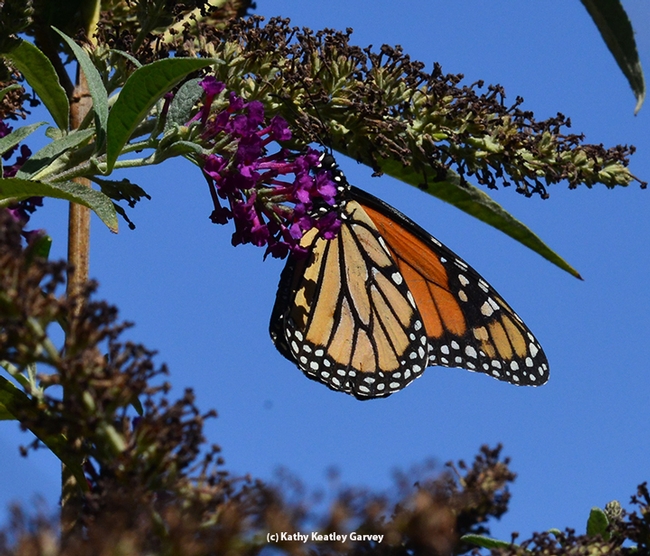The Monarchs are on the move.
In the late summer and early fall, the Monarchs (Danaus plexippus) head for the California coastline or central Mexico to overwinter.
"Monarchs west of the Rocky Mountains travel to small groves of trees along the California coast," according to Monarchwatch.org. "Those east of the Rocky Mountains fly farther south to the forests high in the mountains of Mexico. The Monarch's migration is driven by seasonal changes. Daylength and temperature changes influence the movement of the Monarch." See map.
It's a good day when we see a single monarch in our Vacaville, Calif. garden re-fueling for the migration. It's a great day when we see two. It's a super, super wonderful day when we see three. It's a time for cartwheels, handstands and pirouettes.
Only a Monarch can get us that excited. Gulf Fritillaries, Western Tiger Swallowtails, and Anise Swallowtails come close. Mourning Cloaks, Painted Ladies and Acmon Blues? Not so much.
The aptly named butterfly bush (Buddleja davidii) draws them all, offering nectar they can neither resist nor refuse. Another nectar favorite in our garden is the Mexican sunfllower (Tithonia).
The female Monarchs are still laying eggs on our milkweed. The result: two chrysalids are hanging in our butterfly habitat container (purchased from the Bohart Museum of Entomology, University of California, Davis),
Soon, we hope, two more adults will begin that amazing migratory journey to Santa Cruz? Pacific Grove?
Who knows? Right now they're precious jade-green jewels studded in gold. We can see the outlines of the treasures they hold.
Attached Images:

A Monarch nectaring on a butterfly bush. (Photo by Kathy Keatley Garvey)

A Monarch soars, spreading its wings. (Photo by Kathy Keatley Garvey)

A Monarch showing its brilliant colors. (Photo by Kathy Keatley Garvey)

A Monarch, outlined against a blue sky, sips nectar from a butterfly bush. (Photo by Kathy Keatley Garvey)